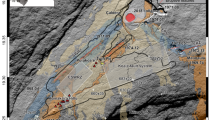Abstract
The Wildhorn-Nappe of Switzerland contains a series of ancient normal, longitudinal (or strike) faults which moved during Nevadic, Laramic and Intra-Eocene times. The ages of the movements are proved by the stratigraphy. The faults occur in three zones in Western Switzerland and in four zones East of the Lake of Thun in Eastern Switzerland.
The longitudinal fault-bounded blocks were later folded, together with higher nappes that had already been thrust over them, by the Helvetian orogenesis; and the Western Wildhorn-Nappe is now largely composed of the folded fault-blocks. They lie one behind the other bounded by the ancient longitudinal dislocations. Jurassic, Cretaceous, and Tertiary strata have been thrown against each other, but never so far that the stratigraphical connection between the different blocks is lost.
The Cretaceous beds between the Lake of Thun and the Lake of Lucerne have become separated from their underlying Jurassic strata and form, together with the Tertiary beds, a nappe of their own. This unit can be subdivided into the Niederhorn-Pilatus-Nappe containing the northern facies of the Cretaceous; the Waldegg-Buergenstock-Nappe which contains the southern facies of the Cretaceous; and three southern folds that are formed from Cretaceous of extreme southern type. These three folds, here referred as to the Drusberg-Nappe, can be traced from Western Switzerland as far as the lake of Lucerne and Lake of Uri.
The three folds rest on southern Jurassic rocks in the Western Wildhorn-Nappe, and on Jurassic in the Bernese Oberland and Obwalden. East of Interlaken they travelled still further north-west and now lie north of the northern Jurassic. In spite of these different geological settings the three folds consisting of southern Cretaceous persist, and they are always accompanied and bounded by the ancient faults mentioned above.
The structural arrangements in the Wildhorn-Nappe change a little East of the Lake of Uri. There the beds of northern Cretaceous type remained in stratigraphical contact with a fold core of northern Jurassic strata, and the whole forms the Axen-Nappe. Ancient fault-blocks consisting of southern Cretaceous fades, and showing evidence of later folding lie north of the Axen-Nappe; these are remnants of the overthrust Wiggis-Nappe (= Waldegg-Buergenstock-Nappe), Raederten-Nappe, and Drusberg-Nappe. The two last — Raederten- and Drusberg-Nappes — contain the continuation of the three folds of the southern Wildhorn-Nappe of Western Switzerland.
The ancient fault-planes are believed to have had a steep dip in the western Wildhorn-Nappe, and the faulted units remained in their original sequence, one behind the other. In the eastern Wildhorn-Nappe they originally cut the sediments at a low angle of dip, and secondary nappes have thus developed.
Five different movements can thus be recognized within the Wildhorn-Nappe:
-
1.
Faulting during the geosynclinal phase;
-
2.
Folding due to compression during the beginning of the Helvetic orogeny;
-
3.
Shearing movements due to compression, i. e. birth of the Wildhorn-Nappe;
-
4.
Transportation, at first by compression, then by gravitational sliding;
-
5.
A combination of compression and uplift to restore isostatic balance caused rock-wedges to penetrate upwards from the autochtonous foundation during the transportation phase. The upward movement of these wedges assisted in the gravity sliding of the nappes. Secondary foldings may also have occured during the mise-en-place of the nappe.
Similar content being viewed by others
Schriften
Badoux, H.: L'Ultra-helvétique au Nord du RhÔne valaisan. Mat. carte géol. Suisse, N. S. Livr.85, 1946.
Glangeaud, L.: Le rÔle des Failles dans la structure du Jura externe. Bull. soc. d'hist. nat. du Doubs, No. 51, 1944.
Günzler-Seiffert, H.: Gefaltete Brüche im Jura des Kientals. Ecloges25, No. 2, 1932. - Persistente Brüche im Jura der Wildhorndecke des Berner Oberlandes. Eclogae34, No. 2, 1944. - Ein jungkimmerischer Querbruch in der östlichen Faulhorngruppe. Eclogae39, No. 2, 1946.
Helbling, R.: Zur Tektonik des St. Galler Oberlandes und der Glarneralpen. Beitr. geol. Karte Schweiz, N. F. Liefg.76, 1938.
Jeannet, A.: Sur des cassures nummulitiques dans les Alpes de Schwyz (Suisse centrale). C. R. soc. géol. France, No. 6, 1939. - Geologie der oberen Sihltaler Alpen (Kt. Schwyz). Ber. schwyz. natf. Ges. Heft 3, 1938/40, 1941.
Leupold, W.: Neue Beobachtungen zur Gliederung der Flyschbildungen der Alpen zwischen Reu\ und Rhein. Eclogae35, No. 2, 1942.
Lugeon, M., etGagnebin, E.: Observations et vues nouvelles sur la géologie des Préalpes Romandes. Mem. soc. vaud. sci. nat., No. 47, vol. 7, No. 1, 1941.
Stille, H.: Einführung in den Bau Amerikas. Bornträger, Berlin 1940.
Wegmann, E.: Note sur quelques problèmes de la tectonique superposée. C. R. Soc. géol. Finl., 20, 1947.
Author information
Authors and Affiliations
Rights and permissions
About this article
Cite this article
Günzler-Seiffert, H. Alte Brüche im Kreide/Tertiär-Anteil der Wildhorndecke Zwischen Rhone und Rhein. Geol Rundsch 40, 211–239 (1952). https://doi.org/10.1007/BF01803434
Issue Date:
DOI: https://doi.org/10.1007/BF01803434




